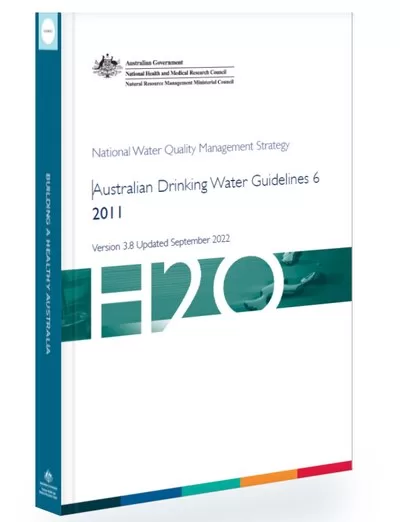This page examines the Australian federal government and each state’s efforts to regulate and monitor the onshore gas industry.
The Australian Drinking Water Guidelines constantly evolves
The Australian Drinking Water Guidelines provide a framework for determining and managing the quality of water to be supplied to consumers in all parts of Australia.
The Guidelines are not mandatory legally enforceable standards and the implementation of the guidelines is at the discretion of each state and territory and their health departments, drinking water regulators, local health authorities and water utilities.
The Australian Drinking Water Guidelines are one area of government standards that the gas industry has to consider and negotiate through as they expand gas exploration and production onshore.
The 2004 Australian Drinking Water Guidelines were developed by National Health and Medical Research Council in collaboration with the Natural Resource Management Ministerial Council and were rescinded and replaced in 2011 to include:
° additional material on pharmaceuticals and endocrine disruptors;
° a rewrite of the monitoring chapters;
° additional micro-organism fact sheets; and
° an additional 130 pesticide fact sheets..
In the past few years there have been reviews and updates on:
° Chemical fact sheets on Benzene, Toluene, Ethylbenzene and Xylenes (BTEX) were reviewed;
° short-term exposure values where temporary drinking water contamination occurs;
° microbial quality of drinking water;
° changes to the glyphosate factsheet;
° new factsheets on lanthanum and also on Per-fluoroalkyl and poly-fluoroalkyl substances (PFAS) to determine Australian Tolerable Daily Intakes (TDIs) for perfluorooctane sulfonate (PFOS), perfluorooctanoic acid (PFOA) and perfluorohexane sulfonate (PFHxS).
View and download the Australian Drinking Water Guidelines here.
Fracking > Australia > Federal > Australian Drinking Water Guidelines

°°°°
Fracking > Australia > Western Australia >
Hydraulic fracturing in the onshore gas industry and drinking water
Western Australia has only shale and tight gas deposits. If not done correctly, the fraccing process has the potential to contaminate surface and underground drinking water sources.
The risk of contaminating a drinking water reserve depends on the separation between the underground (aquifer) or the surface catchment area and the fraccing operation. In addition, the type and concentration of chemicals in stimulating fluids and the chemical by-products produced during the production of gas may impact upon drinking water reserves.
The Department of Mines, Industry Regulation and Safety (DMIRS) (external site) regulates hydraulic fracture stimulation in Western Australia. Since 2018 fraccing has been prohibited within 2000 metres of gazetted Public Drinking Water Source Areas and all onshore fraccing proposals will be referred to the Environmental Protection Authority (EPA) for assessment under the Environmental Protection Act 1986.
The EPA has agreed to refer all new proposals with the potential to impact drinking water sources to the Department of Health for review. The Department will also assess any proposals to reuse the product water to ensure the reuse is fit-for-purpose and that sufficient control measures are in place to prevent harm.
Source: Government of Western Australia, Department of Health website
°°°°
Fracking > Australia > NSW >
WaterNSW Principles for Managing Mining and Coal Seam Gas Impacts in Declared Catchment Areas
WaterNSW opposes coal seam gas activities within the Special Areas as it is inconsistent with its objectives and functions as defined in the Water NSW Act 2014.
WaterNSW was established to provide a safe and reliable supply of raw water suitable for treatment to drinking water standards. To meet this objective WaterNSW manages its land, the Sydney drinking water catchments and infrastructure including water storages, to protect water quality and quantity.
In Declared Catchment Areas mining and coal seam gas activities must not result in a reduction in the quantity of surface and groundwater inflows to storages or loss of water from storages or their catchments.
Mining and coal seam gas activities can impact on catchments, water quantity, water quality and water supply infrastructure. Mining in the Sydney drinking water catchment is likely to continue until at least 2050 with large areas of the catchment subject to mining production titles.
Eighty three percent of Special Area land close to the water storages is under a mining production or exploration title. There are active mines in the Special Areas and close to WaterNSW water supply infrastructure works. They can damage infrastructure including dams, water storages, the canals and pipelines.
The NSW Department of Planning and Environment, Office of Coal Seam Gas, Planning Assessment Commission and the Department of Industry are responsible for assessing and approving mining and coal seam gas activities.
Mining and coal seam gas activities must not pose increased risks to human health as a result of using water from the drinking water catchments.
WaterNSW opposes mining (first or second workings) under any of its prescribed dams. Subsidence from mining and coal seam gas activities can impact on, and destabilise, water supply infrastructure. Mining and coal seam gas activities can also affect the integrity of monitoring sites that are cri
The ecological integrity of the Special Areas must be maintained and protected.
Sound decisions about mining and coal seam gas proposals rely on a robust environmental impact assessment process. In particular, there must be adequate and reliable data and information on the potential impacts on water quantity and quality.
Major mining and coal seam gas projects may involve several components – exploration drilling, building underground access roads and ventilation shafts, extracting, processing and transporting coal or gas. The environmental planning assessment should be undertaken for the entire project holistically, not stage by stage.
WaterNSW Mining Principles on their website, and mirrored on 1EarthMedia
°°°°
Federal > Australian Drinking Water Guidelines
Is fracking good for your health?
An analysis of the impacts of unconventional gas on health and climate
Technical Brief No. November 2013 (PDF on The Australia Institute website and mirrored on the 1EarthMedia website)
° While the risk of water contamination by fracturing fluids cannot be dismissed, risks from wastewater are more concerning. Wastewater contains both fracturing fluids and naturally occurring contaminants, with many reported spills and accidents here and overseas.
° There is substantial uncertainty regarding the human health implications of unconventional gas extraction, however there are many exposure pathways and known health hazards including the possibility of water contamination from fracturing chemicals and wastewater; air pollution; and decreased soil quality.
° The potential for water contamination by the fluids used in fracking has been at the forefront of public debate. Approximately 18,500 kg of additives are injected in fracking one CSG well in Australia, with potential health impacts associated with fracking chemicals including cancer, skin and eye irritation, respiratory problems, damage to the nervous system, cells and blood, endocrine disruption and reproductive problems.
There are several areas of concern regarding pathways in unconventional gas developments including direct contamination, and contamination by stranded fluids and abandoned wells, although there is little by way of concrete evidence.
However, while these risks cannot be dismissed, evidence suggests that naturally occurring contaminants such as heavy metals and naturally occurring radioactive materials (NORMs) in wastewater pose greater hazards, with wastewater treated and released in Australia found to contain boron, silver, chlorine, copper, cadmium, cyanide and zinc.
Resource conflict between the gas industry and other industries over access to land and water, impacts on biodiversity, and long-term soil and water health are also likely to have implications for food security and environmental health.
Modelling such impacts, especially over the long-term, is complex, but the potential impacts are more serious than many other energy sources, and especially salient in Australia given its heavy reliance on agricultural production.
Unconventional gas extraction involves intensive water use, which is especially of concern in Australia due to our reliance on water resources for food security—and our vulnerability to drought, a vulnerability that is likely to be exacerbated by climate change.
The likely consequences of fracturing for water supply and quality has attracted considerable attention, with a major report on drinking water quality being undertaken by the US EPA and the Australian Government also undertaking an extensive investigation.
There are several intersecting pathways that will be considered here: the contamination of aquifers by fracturing and drilling fluids; methane contamination; cross-contamination; water use and wastewater. Water can also affect health through atmospheric emissions from wastewater, and soil pollution.
While there are few confirmed instances of direct contamination by fracturing fluids or cross contamination of aquifers, these risks cannot be dismissed—especially in light of the potential effect of seismic activity caused by the fracturing process and the impacts of climate change.
The potential hazards of wastewater are even more concerning, with many potential risk pathways and a mix of fracturing fluids and naturally occurring contaminants (including radioactive materials) posing serious health concerns.
Water use is a particularly salient issue in Australia, with resource conflict a likely result of the industry’s expansion.
The contamination of underground aquifers by fracturing and drilling chemicals, which may in turn be used as a source of drinking water or for irrigation, has been a source of particular public concern. The evidence suggests that direct contamination is a low risk in properly managed operations, though it cannot be dismissed entirely.
There are also considerable knowledge gaps concerning the fate of stranded fracturing fluids and the potential for seismic activity caused by fracturing or the re-injection of wastewater to damage well casings.
The CSIRO also claim that groundwater contamination from CSG operations is a low risk, due in part to the low toxicity and dilution of chemicals, as well as the removal of fluids and the presence of aquitards, concluding that: “Hydraulic fracturing, when conducted correctly, is unlikely to introduce hazardous concentrations of chemicals into groundwater”.
A 2004 US EPA report concluded that there was “little to no risk of fracturing fluid contaminating underground sources of drinking water during hydraulic fracturing of coal bed methane production wells”. However, this report attracted much criticism and another report is due for release in 2014.
However, there are many case studies that indicate the contamination of water supplies in direct connection with hydraulic fracturing operations, with at least one confirmed instance in the US. In Australia, BTEX chemicals were found in a fracturing operation, and benzene and toluene were discovered in the water in an underground coal gasification project.
A compilation of case studies from the US lists many additional unconfirmed instances, including a well containing “50 times the acceptable level of hexavalent chromium” and “elevated levels of arsenic, lead, chromium, butanone, acetone, carbon disulfide, and strontium” at a nearby location.
Water pollution risks can also be exacerbated by seismic activity caused by fracturing. While the evidence strongly suggests that such seismic activity will not be of a level that would be felt above ground, even small seismic events pose an additional risk to well casing integrity—as demonstrated by the event in the Preese Hall shale reservoir in the UK that led to gas company Cuadrilla suspending its activities.
An area that has not received much attention is the risk associated with abandoned wells and stranded fracturing fluids. One report estimated that one in six abandoned wells was “releasing its contents to the surrounding area, including the surface” in the US, and it has been claimed that up to 85% of fluids may remain underground53 (although considerably lower figures of around 20-40% are usually estimated).
Fracking > Australia > Federal > Australian Drinking Water Guidelines



